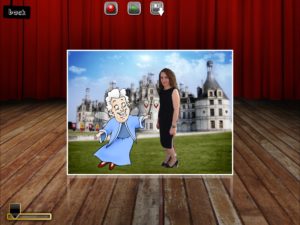We’re thrilled to share today’s guest post with USSAAC members and guests. Lauren Enders is a speech-language pathologist and augmentative communication consultant who has many fun-filled ideas for using apps in language therapy for individuals using AAC. Enjoy!
—–
I am lucky enough to have a career that allows me to support teachers, therapists, paraprofessionals and families as they navigate the world of augmentative and alternative communication (AAC). As I gain more and more experience in the field of AAC, I’ve found that one of the questions that resurfaces constantly is “HOW do I teach language to someone learning to communicate using AAC?” When I respond to this common question, I always share an important consideration. To learn any skill, we need to be engaged. The more engaged we are, the quicker we learn and the more likely we are to learn (and want to communicate)! So often, in our well-intentioned pursuit of developing competent communicators, we use activities that turn learning language into a test or a demand. When we are able to shift our focus to modeling and teaching language within highly engaging and interactive activities, we can foster more language growth and build better relationships!
I spend lots of time exploring easy to implement language-building activities that I can share with teams and families. The games, activities, and therapy tools I recommend typically have the following features in common. They
- are engaging and fun (across the age span)
- are reusable
- are open-ended
- are (mostly) low-cost or free
- can be directed or guided by the communication partner
- consider the learner’s interests and allow us to follow his or her lead
I have found that one of the most popular types of activities that meet the above criteria are a  selection of mobile apps in several app categories. Because today’s children (and adults) are so tuned in to mobile devices and because many of us have constant access to these devices, apps can be an excellent addition to our language-teaching “toolbox.” Among the app categories I love to demonstrate and share are open-ended play apps, live photo filter apps, augmented reality apps, and
selection of mobile apps in several app categories. Because today’s children (and adults) are so tuned in to mobile devices and because many of us have constant access to these devices, apps can be an excellent addition to our language-teaching “toolbox.” Among the app categories I love to demonstrate and share are open-ended play apps, live photo filter apps, augmented reality apps, and
digital storytelling apps with screen recording capability.
OPEN-ENDED PLAY APPS
When I speak about open-ended play apps, I often explain them to people as souped-up Colorforms® (movable plastic cling stickers on backgrounds) with interactive elements including music, animation, and sound effects. With these apps, there is not an intended beginning or end nor is there a way to win or lose. They are simply made to encourage open-ended free play that lends itself beautifully to eliciting language from those learning to communicate using AAC. You can choose characters and backgrounds and decide what happens to the characters and objects within the app. Apps that allow you to take a photo of your language learner and insert it into the app can be particularly engaging. I find these types of apps most suitable for use with children. Some of the apps I love to use include:
- MyPlayHome Apps (iOS, Android, Amazon, Windows) https://www.myplayhomeapp.com
- Sago Mini Apps (iOS, Android, Amazon) https://sagomini.com/en/
- Pepi Play Apps (iOS, Android) I really love Pepi Bath 2! https://www.pepiplay.com
- Toca Boca Apps (iOS, Android, Kindle Fire) Toca Hair Salon me is a favorite! https://tocaboca.com/apps/
- Shoe the Goose Apps (iOS) http://www.shoethegoose.com
LIVE PHOTO FILTER APPS
Another category of apps that I love to use with language learners who use AAC are live photo

A live photo filter app was used to give Lauren a cowboy hat, bandana, and blue eyes!
filter apps. You may be familiar with these apps as they are the fun filters you can use in SnapChat. There are many options for working on various language targets with these apps and they often appeal to all ages. Additionally, most of these apps allow you to take stills and videos with the filters in place, which can add lesson extensions for these language activities! Be aware that most of these apps offer in-app purchases or options for monthly subscriptions. Also be sure to check that all filters within the apps you select are appropriate before using with a student! Some of my favorite live photo filter apps include: include:
- MSQRD (iOS, Android)
- MRRMRR (iOS, Android)
- YouCam Fun Live Face Filters (iOS, Android)
- Epic Photo Stickers Toon Blitz (iOS)
- Modiface Makeup (iOS, Android)
- https://itunes.apple.com/us/app/makeup/id314603460?mt=8
- https://play.google.com/store/apps/details?id=com.modiface.virtualmakeover&hl=en_US
- Other apps allow you to change hair color and eye color!
AUGMENTED REALITY APPS
Augmented Reality (AR) apps are another wonderful addition to your AAC implementation bag of tricks. With these apps (which also tend to be fun for all ages), you can superimpose a wide variety of computer-generated images over a view of your world taken using the camera on your device. Your learner can dictate what and where they want items placed in their environment and then talk about what they see! You can then use stills or videos you take within the app for additional language activities. I started a trend this year at the Closing the Gap conference with attendees posting photos of dinosaurs roaming the conference hall! What fun!
- Leo Augmented Reality Video/Leo AR (iOS, Android)
- Figment AR (iOS, Android)
- Do Not Touch by Nickelodeon (iOS)
- CamAR Animals – AR Stickers (iOS)
- Action Movie FX (iOS)
- Monster Park – AR DinoWorld (iOS, Android)
DIGITAL STORYTELLING APPS WITH SCREENCASTING FEATURES

Lauren appears in a fairytale scene in a screen shot from Puppet Pals.
Digital storytelling apps are yet another activity idea. They allow you to move characters and objects while recording what happens on screen along with speech or AAC voice output. Some of these apps automatically move the character’s mouth when speech is detected! You can record all of the action and sound and then play back the story as an animated video! Some of my favorites are those that allow you to incorporate your own head and/or body onto characters you manipulate in the story. The creative videos you are able to record within these apps can be emailed to families. What a wonderful way to share with families what their child is saying and what he or she is doing during classes or therapy sessions! Once home, the students can watch the videos they made and talk about them with their family members.
- Puppet Pals 2 (iOS) The paid version of this app allows you to put your head on a character’s body!
- Sock Puppets (iOS)
- ToonTastic 3D (iOS, Android)
- PuppetMaster (iOS) This one lets you make any imported image with a head, arms, torso and legs into a jointed puppet! Fun!
ONE MORE FAVORITE…
One last app that I find to be a HUGE hit with all ages is My Talking Pet Pro. With this app, you make a still picture of an animal (or anything with a head eyes and mouth) talk using a recorded voice (natural speech or AAC voice output). You can even alter the pitch of the recorded voice for extra fun!
- My Talking Pet Pro (iOS, Android)
It’s important to note, that when you use mobile apps as a vehicle for eliciting and working on language development, make sure the language learner is using his or her language to control what YOU do with the app. As the communication partner and language facilitator, you will almost always need to maintain control of the device and manipulate the app based upon the language they provide. If you relinquish control of the device to the language learner, your opportunities for language are likely to plummet while he or she becomes immersed in the physical task of playing with the device. If you are working with a student/client who really needs to be able to be in control, you can always allow a specified amount of time for free play with the app at the end of your session.
The apps I’ve shared by no means represent all app categories or all apps that can be used to help develop language skills of those learning to communicate using AAC. Once you get started using a set of simple, open-ended apps to support language development, it will become much easier to think outside the box and broaden your educational or therapeutic repertoire. Have fun!
—–
 Lauren S. Enders, MA, CCC-SLP is a licensed and ASHA certified Speech Language Pathologist currently working as a full-time Augmentative and Alternative Communication and Assistive Technology (AT) Consultant for Bucks County Intermediate Unit in Bucks County, Pennsylvania. She has had a passion for using AAC and other forms of assistive technology to support students with complex communication needs and complex bodies since she began her career in 1995. Lauren presents regularly at national conferences including Closing the Gap, ATIA, and ASHA as well as more intimate conferences, speaking engagements and webinars. She has shared her knowledge via blog posts on Praacticalaac.org as well as articles published in ASHA Leader and Closing the Gap Solutions Magazines. Lauren enjoys sharing AAC and AT related resources and networking with others in the field via her professional social media accounts on Pinterest, Facebook, and Twitter.
Lauren S. Enders, MA, CCC-SLP is a licensed and ASHA certified Speech Language Pathologist currently working as a full-time Augmentative and Alternative Communication and Assistive Technology (AT) Consultant for Bucks County Intermediate Unit in Bucks County, Pennsylvania. She has had a passion for using AAC and other forms of assistive technology to support students with complex communication needs and complex bodies since she began her career in 1995. Lauren presents regularly at national conferences including Closing the Gap, ATIA, and ASHA as well as more intimate conferences, speaking engagements and webinars. She has shared her knowledge via blog posts on Praacticalaac.org as well as articles published in ASHA Leader and Closing the Gap Solutions Magazines. Lauren enjoys sharing AAC and AT related resources and networking with others in the field via her professional social media accounts on Pinterest, Facebook, and Twitter.
—–
Jill E Senner, PhD, CCC-SLP
Editor-in-Chief
SpeakUP

2 thoughts on “Mobile Apps for Your AAC Implementation Toolbox”